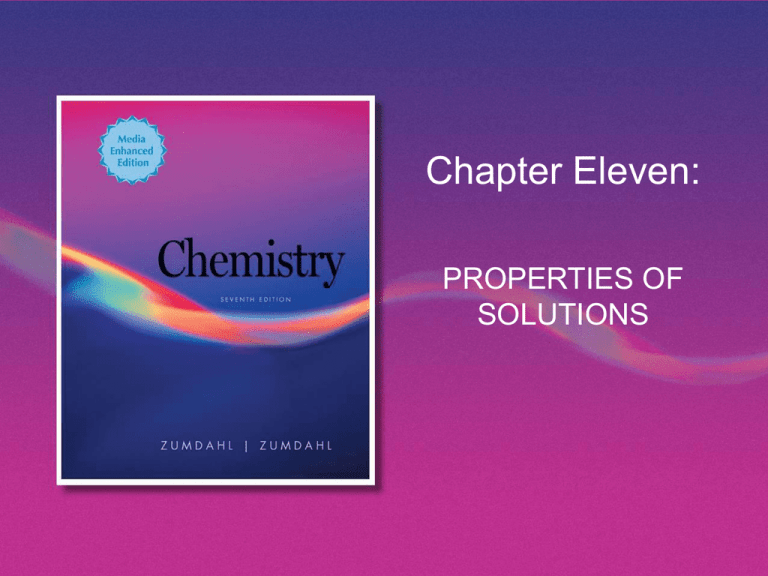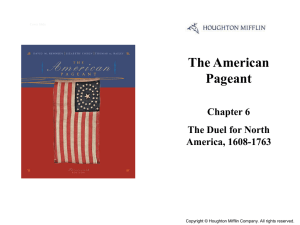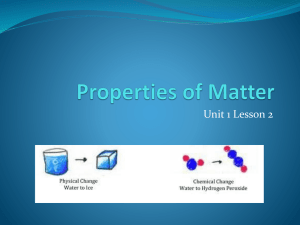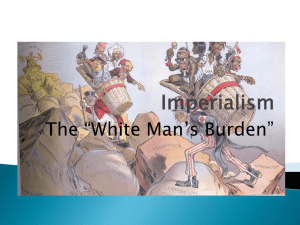
Chapter Eleven:
PROPERTIES OF
SOLUTIONS
Various Types of Solutions
Brass
Carbonated water (soda)
Seawater, sugar solution
State of
Solution
Gas
Liquid
Solid
Liquid
Liquid
State of
Solute
Gas
Liquid
Solid
Gas
Solid
State of
Solvent
Gas
Liquid
Solid
Liquid
Liquid
Hydrogen in platinum
Solid
Gas
Solid
Example
Air, natural gas
Vodka, antifreeze
11.1
Chapter 11 | Slide 2
Copyright © Houghton Mifflin Company. All rights reserved.
Solution Composition
moles of solute
Molarity (M) =
liters of solution
mass
of
solute
Mass (weight) percent =
100%
mass of solution
molesA
Mole fraction (A) =
total moles in solution
moles of solute
Molality (m) =
kilograms of solvent
11.1
Chapter 11 | Slide 3
Copyright © Houghton Mifflin Company. All rights reserved.
Steps in the Dissolving Process
11.2
Chapter 11 | Slide 4
Copyright © Houghton Mifflin Company. All rights reserved.
Concept Check
Explain why water and oil (a long chain
hydrocarbon) do not mix. In your explanation, be
sure to address how ΔH plays a role.
11.2
Chapter 11 | Slide 5
Copyright © Houghton Mifflin Company. All rights reserved.
The Energy Terms for Various Types of
Solutes and Solvents
H1
H2
H3
Hsoln
Polar solvent,
polar solute
Large
Large
Large,
Small
negative
Solution
forms
Polar solvent,
nonpolar solute
Small
Large
Small
Large,
positive
No
solution
forms
Nonpolar solvent,
nonpolar solute
Small
Small
Small
Small
Solution
forms
Nonpolar solvent,
polar solute
Large
Small
Small
Large,
positive
No
solution
forms
Outcome
11.2
Chapter 11 | Slide 6
Copyright © Houghton Mifflin Company. All rights reserved.
In General
• One factor that favors a process is an
increase in probability.
• Processes that require large amounts of
energy tend not to occur.
11.2
Chapter 11 | Slide 7
Copyright © Houghton Mifflin Company. All rights reserved.
Factors Affecting Solubility
• Structural Effects:
– Polarity
• Pressure Effects:
– Henry’s law
• Temperature Effects:
– Affecting aqueous solutions
11.3
Chapter 11 | Slide 8
Copyright © Houghton Mifflin Company. All rights reserved.
Pressure Effects
• Henry’s law:
C = kP
C = concentration
k = constant
P = partial pressure of gas solute
above the solution
• Amount of gas dissolved in a solution is
directly proportional to the pressure of
the gas above the solution.
11.3
Chapter 11 | Slide 9
Copyright © Houghton Mifflin Company. All rights reserved.
A Gaseous Solute
11.3
Chapter 11 | Slide 10
Copyright © Houghton Mifflin Company. All rights reserved.
Temperature Effects (Aq Solns)
• Although the solubility of most solids in
water increases with temperature, the
solubilities of some substances
decrease with increasing temperature.
• Predicting temperature dependence of
solubility is very difficult.
• Solubility of a gas in water typically
decreases with increasing
temperature.
11.3
Chapter 11 | Slide 11
Copyright © Houghton Mifflin Company. All rights reserved.
The
Solubilities
of Several
Solids as a
Function of
Temperature
Chapter 11 | Slide 12
Copyright © Houghton Mifflin Company. All rights reserved.
The
Solubilities
of Several
Gases in
Water
Chapter 11 | Slide 13
Copyright © Houghton Mifflin Company. All rights reserved.
An Aqueous Solution and Pure Water in
a Closed Environment
11.4
Chapter 11 | Slide 14
Copyright © Houghton Mifflin Company. All rights reserved.
Liquid/Vapor Equilibrium
11.4
Chapter 11 | Slide 15
Copyright © Houghton Mifflin Company. All rights reserved.
Vapor Pressure Lowering: Addition of a
Solute
11.4
Chapter 11 | Slide 16
Copyright © Houghton Mifflin Company. All rights reserved.
Vapor Pressures of Solutions
• Nonvolatile solute lowers the vapor
pressure of a solvent.
• Raoult’s Law:
Psoln = ΧsolvPosolv
Psoln = observed vapor pressure of soln
Χsolv = mole fraction of solvent
Posolv= vapor pressure of pure solvent
11.4
Chapter 11 | Slide 17
Copyright © Houghton Mifflin Company. All rights reserved.
A Solution
Obeying
Raoult’s Law
Chapter 11 | Slide 18
Copyright © Houghton Mifflin Company. All rights reserved.
Nonideal Solutions
• Liquid-liquid solutions where both
components are volatile.
• Modified Raoult’s Law:
PTotal = ΧAPoA + ΧBPoB
11.4
Chapter 11 | Slide 19
Copyright © Houghton Mifflin Company. All rights reserved.
Summary of the Behavior of Various Types
of Solutions
Interactive Forces
Between Solute (A) and
Solvent (B) Particles
Hsoln
T for
Solution
Formation
Deviation
from
Example
Raoult’s
Law
None
Benzene(ideal
toluene
solution)
A A, B B A B
Zero
Zero
A A, B B < A B
Negative
(exothermic)
Positive
Negative
Acetonewater
A A, B B > A B
Positive
(endothermic)
Negative
Positive
Ethanolhexane
11.4
Chapter 11 | Slide 20
Copyright © Houghton Mifflin Company. All rights reserved.
Concept Check
For each of the following solutions, would you
expect it to be relatively ideal (with respect to
Raoult’s Law), show a positive deviation, or show
a negative deviation?
a) Hexane (C6H14) and chloroform (CHCl3)
b) Ethyl alcohol (C2H5OH) and water
c) Hexane (C6H14) and octane (C8H18)
11.4
Chapter 11 | Slide 21
Copyright © Houghton Mifflin Company. All rights reserved.
Colligative Properties
• Depend only on the number, not on the
identity, of the solute particles in an ideal
solution:
– Boiling-point elevation
– Freezing-point depression
– Osmotic pressure
11.5
Chapter 11 | Slide 22
Copyright © Houghton Mifflin Company. All rights reserved.
Boiling-Point Elevation
• Nonvolatile solute elevates the boiling
point of the solvent.
• ΔT = Kbmsolute
ΔT = boiling-point elevation
Kb = molal boiling-point elevation constant
msolute = molality of solute
11.5
Chapter 11 | Slide 23
Copyright © Houghton Mifflin Company. All rights reserved.
Boiling Point Elevation: Liquid/Vapor
Equilibrium
11.5
Chapter 11 | Slide 24
Copyright © Houghton Mifflin Company. All rights reserved.
Boiling Point Elevation: Addition of a
Solute
11.5
Chapter 11 | Slide 25
Copyright © Houghton Mifflin Company. All rights reserved.
Boiling Point Elevation: Solution/Vapor
Equilibrium
11.5
Chapter 11 | Slide 26
Copyright © Houghton Mifflin Company. All rights reserved.
Freezing-Point Depression
• When a solute is dissolved in a solvent,
the freezing point of the solution is lower
than that of the pure solvent.
• ΔT = Kfmsolute
ΔT = freezing-point depression
Kf = molal freezing-point depression constant
msolute = molality of solute
11.5
Chapter 11 | Slide 27
Copyright © Houghton Mifflin Company. All rights reserved.
Freezing Point Depression: Solid/Liquid
Equilibrium
11.5
Chapter 11 | Slide 28
Copyright © Houghton Mifflin Company. All rights reserved.
Freezing Point Depression: Addition of
a Solute
11.5
Chapter 11 | Slide 29
Copyright © Houghton Mifflin Company. All rights reserved.
Freezing Point Depression:
Solid/Solution Equilibrium
11.5
Chapter 11 | Slide 30
Copyright © Houghton Mifflin Company. All rights reserved.
Changes in Boiling Point and Freezing
Point of Water
11.5
Chapter 11 | Slide 31
Copyright © Houghton Mifflin Company. All rights reserved.
Exercise
• You take 20.0 g of a sucrose (C12H22O11) and
NaCl mixture and dissolve it in 1.0 L of water.
The freezing point of this solution is found to be
-0.426°C. Assuming ideal behavior, calculate
the mass percent composition of the original
mixture, and the mole fraction of sucrose in the
original mixture.
11.5
Chapter 11 | Slide 32
Copyright © Houghton Mifflin Company. All rights reserved.
Exercise
• A plant cell has a natural concentration of
0.25 m. You immerse it in an aqueous solution
with a freezing point of –0.246°C. Will the
cell explode, shrivel, or do nothing?
11.5
Chapter 11 | Slide 33
Copyright © Houghton Mifflin Company. All rights reserved.
Osmotic Pressure
• Osmosis – flow of solvent into the
solution through a semipermeable
membrane.
• π = MRT
π = osmotic pressure (atm)
M = molarity of the solution
R = gas law constant
T = temperature (Kelvin)
11.6
Chapter 11 | Slide 34
Copyright © Houghton Mifflin Company. All rights reserved.
Osmotic Pressure
11.6
Chapter 11 | Slide 35
Copyright © Houghton Mifflin Company. All rights reserved.
Osmosis
11.6
Chapter 11 | Slide 36
Copyright © Houghton Mifflin Company. All rights reserved.
Exercise
• When 33.4 mg of a compound is dissolved in
10.0 mL of water at 25°C, the solution has an
osmotic pressure of 558 torr. Calculate the
molar mass of this compound.
11.6
Chapter 11 | Slide 37
Copyright © Houghton Mifflin Company. All rights reserved.







